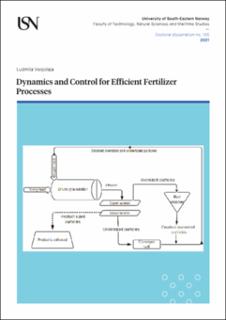| dc.contributor.author | Vesjolaja, Ludmila | |
| dc.date.accessioned | 2021-09-29T09:04:20Z | |
| dc.date.available | 2021-09-29T09:04:20Z | |
| dc.date.issued | 2021-10-11 | |
| dc.identifier.isbn | 978-82-7206-626-9 | |
| dc.identifier.issn | 2535-5252 | |
| dc.identifier.uri | https://hdl.handle.net/11250/2785938 | |
| dc.description.abstract | Granulation processes have been a subject of research for more than 60 years. During these years of research, there has been a significant improvement in qualitative and quantitative knowledge of the granulation processes, their behaviour and dependence on various process variables and properties. However, in spite of extensive research in the granulation field, industrial granulation plants still suffer from oscillatory behaviour in the product quality and quantity. Typically, the oscillatory behaviour is observed in continuous granulation loop plants where off-spec particles are recycled back into the granulator. The observed oscillatory behaviour leads to a reduction in profit, overloading of the process equipment, increased operational risks, and unforeseen plant shut-downs. Consequently, the elimination of the oscillatory behaviour in the continuous granulation loop plants is of great importance. Towards this goal, mathematical modelling with control of the granulation loop process is an important task. Thus, the thesis focuses on modelling and control of the continuous drum granulation processes with particle recycle.
The development of an efficient mathematical model that can be used for further control purposes, is studied in this research. One of the most important units in the granulation loop required for the overall model development is the granulator. In the granulator particle growth and particle collision occurs. In the thesis, macro-scale modelling of the granulation process is used. Different granulation mechanisms are investigated for developing the granulator model. Several discretization schemes (for the internal and the external coordinate discretization) are applied and used for finding the numerical solution of the resulting model. This model of the granulation loop process includes models of the granulator, screens, and a crusher.
Further, the developed granulation loop model is used for control studies. Several possibilities are investigated in order to eliminate the oscillatory behaviour seen in granulation loop plants. The thesis suggests the manipulation of either the crusher gap spacing or the fraction of the recycled product-sized particles to eliminate the oscillatory behaviour seen in the product quality. In the thesis, both classical control (PI controller or P+PI controllers) and advanced control (model predictive control) have been applied to control the produced particle size in the granulation process. | en_US |
| dc.language.iso | eng | en_US |
| dc.publisher | University of South-Eastern Norway | en_US |
| dc.relation.ispartofseries | Doctoral dissertations at the University of South-Eastern Norway;105 | |
| dc.relation.haspart | Paper A: Vesjolaja, L., Glemmestad, B. & Lie, B.: Solving the population balance equation for granulation processes: particle layering and agglomeration. Proceedings of the 61st International Conference of Scandinavian Simulation Society, SIMS 2020, p. 180-187, 2020. https://doi.org/10.3384/ecp20176180 | en_US |
| dc.relation.haspart | Paper B: Vesjolaja, L., Glemmestad, B. & Lie, B.: Population balance modelling for fertilizer granulation process. Proceedings of the 59th International Conference of Scandinavian Simulation Society, SIMS 2018, p. 95-102, 2018. https://doi.org/10.3384/ecp1815395 | en_US |
| dc.relation.haspart | Paper C: Vesjolaja, L., Glemmestad, B. & Lie, B.: Application of population balance equation for continuous granulation process in spherodizers and rotary drum. Proceedings of the 61st International Conference of Scandinavian Simulation Society, SIMS 2020, p. 172-179, 2020. https://doi.org/10.3384/ecp20176172 | en_US |
| dc.relation.haspart | Paper D: Vesjolaja, L., Glemmestad, B. & Lie, B.: Dynamic model for simulating transient behaviour of rotary drum granulation loop. Model, Identification and Control, 41(2), (2020), 65-77. https://doi.org/10.4173/mic.2020.2.3 | en_US |
| dc.relation.haspart | Paper E: Vesjolaja, L., Glemmestad, B. & Lie, B.: Double-Loop Control Structure for Rotary Drum Granulation Loop. Processes, 8(11), (2020), 1423. https://doi.org/10.3390/pr8111423 | en_US |
| dc.relation.haspart | Paper F: Vesjolaja, L., Glemmestad, B. & Lie, B.: Comparison of feedback control strategies for operation of granulation loops. Preprint. Submitted to Journal of Information Technology and Control. | en_US |
| dc.relation.haspart | Paper G: Vesjolaja, L., Glemmestad, B. & Lie, B.: Non-linear model based predictive control for drum granulation loop process. Preprint. Submitted to Computers and Chemical Engineering. | en_US |
| dc.rights.uri | http://creativecommons.org/licenses/by-nc-sa/4.0/deed.en | |
| dc.subject | granulation loop | en_US |
| dc.subject | particle agglomeration | en_US |
| dc.subject | particle layering | en_US |
| dc.subject | dynamic population balance model | en_US |
| dc.subject | PI control | en_US |
| dc.subject | non-linear model predictive control | en_US |
| dc.title | Dynamics and Control for Efficient Fertilizer Processes | en_US |
| dc.type | Doctoral thesis | en_US |
| dc.description.version | publishedVersion | en_US |
| dc.rights.holder | © The Author, except otherwise stated | en_US |
| dc.subject.nsi | VDP::Teknologi: 500::Kjemisk teknologi: 560::Kjemisk prosessteknologi: 562 | en_US |

